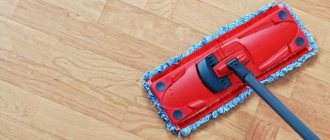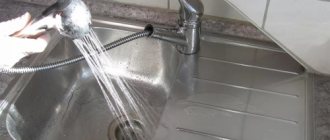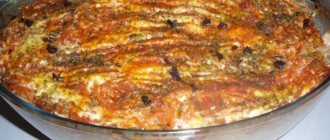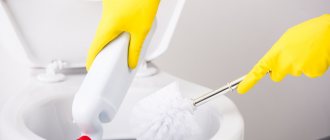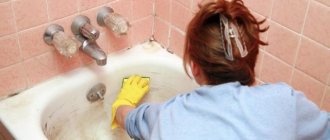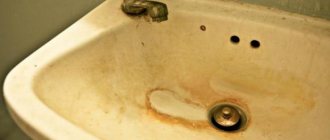The kitchens of many of our customers are equipped with stainless steel sinks, the popularity of which is due not only to affordability. Steel sinks harmonize with many types of materials and, with proper care, retain their impeccable appearance for a long time. They are also aesthetically pleasing, hygienic, and, most importantly, practical.
From the article you will learn why durable stainless steel sinks need gentle and careful care. We'll tell you how to clean stains from stainless steel sinks and what products can be used to remove plaque and rust.
Image by fiatlux (source – flickr.com)
Fighting specific stains
Contaminants on a ceramic sink can be of different nature: rust, plaque, dyes, grease. It’s not easy to deal with such stains, but you can choose special-purpose formulations from among the range of detergents. Therefore, the type and nature of contamination must be determined.
White limescale
It is nothing more than water salts that remain on the surface of the sink after the moisture has dried. You can avoid their appearance by installing a filter. Improving the quality of water means freeing it from salts, and less plaque is formed. If this is not done, white spots and stains will appear. They are not easy to remove, but it is possible.
How to remove plaque from a ceramic sink? You can use home methods:
- treating the washing surface with a bleach solution once a week. You need to close the drain hole, apply liquid, leave for 20 minutes, rinse with warm water and wipe dry;
- scrubbing away plaque stains using household bleach. Please note that this composition is quite aggressive. It is not recommended to use it more than once every 14 days. Before use, you will need to dilute it with water (1:3) and treat the sink with a spray bottle and leave overnight (up to 14 hours). Then wipe with a sponge and rinse with water;
- Vinegar is one of the first aides when cleaning a ceramic sink at home. It is simply applied to the surface, allowed to stand for 3 minutes and rinsed. For old stains, apply a cloth soaked in vinegar and leave for 15–20 minutes;
- ammonia. Another handy tool that will help remove limescale stains. How to clean a ceramic sink from plaque using ammonia? It's simple: you need to make a special composition from water and this product, adding a few drops per 200 ml of liquid. Apply the product to the sink, leave for 10 minutes and rinse off.
Although the list contains available means, when working with them, as with industrial compounds, you should adhere to safety rules. Before cleaning the sink, you need to wear gloves and a respirator. Caustic substances can cause ulcers on the hands, and toxic fumes can lead to poisoning or burns to the respiratory tract.
Removing traces of rust
Worn out taps and old fittings often lead to red spots appearing on sinks. This is rust. It distorts the beauty of a ceramic sink. If you leave stains, then over time they eat away, and it becomes very difficult to clean them. Therefore, it is worth removing contaminants literally immediately after they form. Home remedies will help with this.
How to clean a ceramic sink if it has rust? Remember effective recipes:
- A solution of ammonia peroxide in proportion 1: The resulting product is applied with a sponge to the rust stain and left for a while. When the components are mixed, a chemical reaction occurs that helps clean the composite. Then you just need to rinse the sink with water. It is advisable to clean it with ammonia peroxide once a week so that rust does not have time to eat into the material.
- Coca-Cola + spray bottle. You may be surprised, but the world-famous drink perfectly cleanses the composite of contaminants. You need to spray Cola on the stains and leave for an hour. Next you will need to rub the stain with a sponge and rinse with water. The same method works with cleaning other delicate surfaces - acrylic, enamel. Several processing cycles - there will be no trace of rust left.
In addition to a sponge, you should stock up on an old brush (toothbrush, for example). It is convenient to wipe off dirt from corrugated surfaces.
After cleaning the sink from rust, you should treat the surface with a vinegar solution. It will act as a disinfectant.
Removing traces of coffee
Stains from this drink, like tea, appear as yellowness. You can fight them with lemon juice. You just need to lubricate the contaminated areas with half the fruit, then rub and leave for a couple of hours.
When there is no citrus in the house, but there are stains from coffee and tea, you can use a concentrated solution of citric acid or store-bought products. For example, Pemolux will help. It is sold in powder, which must be diluted with plain water before use. Next, the paste should be applied to the surface of the sink and wait a little.
Fighting varnish stains
These are the most difficult contaminants. They cannot be removed with conventional detergents, which only smear the stain. You can remove nail polish or paint from a ceramic sink using White Spirit solvent.
You need to moisten a cloth or cotton swab in a chemical solution and wipe the stained areas. However, it is important to consider that the solvent is a very toxic and caustic substance. It can damage the surface of a ceramic sink, so it should be used carefully and in small quantities.
How to clean a ceramic sink
To clean a ceramic sink in a bathroom or kitchen, it is recommended to use soft sponges and gel detergents to avoid scratches.
A combination of baking soda and heated vinegar helps clean a ceramic sink from dirt; salt deposits on the walls can be removed using paper towels soaked in vinegar. It is possible to use bleaches (not recommended for color models).
Among the specialized chemicals for ceramics, Master Cleaner is suitable, which is applied to the surface with a sponge, left for up to 20 minutes and thoroughly washed off with water.
Types of sinks and their care
Before cleaning the sink from stains and yellow deposits, you will have to prepare for a hygiene procedure. To do this you will need:
- Remove small debris from the drain. If necessary, clean the drain hole with a plunger. If you don't have a plunger, you can clean the drain with a salt solution. To prepare it, you need to combine two parts warm water and one part table salt.
- Remove unnecessary items from plumbing fixtures - dishwashing gel, liquid soap, sponges, toothbrushes.
- When using cleaning products that contain chlorine, alkalis and acids, ventilate the area and wear protective gloves.
- Prepare soft sponges and sponges that do not scratch surfaces.
Also, when choosing a cleaning agent, you should consider what material the plumbing fixtures are made of. Below we will discuss in detail how to clean different types of sinks.
Enameled
It is quite difficult to care for enamel sinks, since all stains, water deposits and rusty stains are very clearly visible on the shiny surface. In order for such plumbing fixtures to always shine, it is necessary to wash them with gel-like and creamy detergent compositions:
- CIF Active Lemon;
- Sanita;
- Sarma;
- Sidelit.
To clean rust from an enamel tulip sink, use freshly squeezed lemon juice. Procedure:
- Using a soft cloth, apply lemon juice to the stained areas;
- wait twenty to thirty minutes for the product to take effect;
- clean off the rust with the hard side of the sponge;
- wash off dirt with cool water.
To remove yellow stains from a white enamel sink, you must use purified gasoline or nine percent table vinegar. Exposure time is fifteen to twenty minutes.
Stainless steel
A stainless steel kitchen sink is the easiest to clean. Because stainless steel is not susceptible to the settling of lime and grease, as well as the appearance of dark spots. To ensure that such a product always looks neat, you can do the following once a week:
- close the drain;
- fill the sink with hot water;
- add any dishwashing gel that you can find in the house;
- Without releasing the water, walk over all surfaces of the sink with a sponge;
- drain the soapy liquid and rinse the plumbing.
In a situation where dark stains do appear on stainless steel, the following life hack will help to clean a stainless steel sink:
- Place a saucepan with peeled potatoes on the fire.
- Wait until the potatoes are completely cooked.
- Close the drain hole of the metal sink and pour potato broth into it.
- Wait fifteen to twenty minutes.
- Then use a sponge to clean the most problematic areas.
Cast iron sink
Iron and cast iron washbasins can be cleaned either with aggressive products containing caustic compounds or with hard sponges. However, fresh stains are best washed off with regular dishwashing detergent.
If your cast iron sink is stained with grease, remove it with baking soda. To do this, you need to liberally apply an abrasive agent to the wet surfaces of the sink, and actively rub them with the hard side of the sponge. Then - rinse the cleaned plumbing fixtures generously with warm water.
Cleaning ceramic tiles
There are several proven home methods that will help remove rust from ceramic tiles on the floor or walls.
- A good remedy is cream of tartar powder (the sediment formed in barrels of wine). First, the stain is wiped with a peroxide solution, and then sprinkled with this powder and cleaned with a damp sponge.
- Soda is poured onto a washcloth well moistened with simple table vinegar. As soon as they begin to react, quickly remove the rust stain from the tile with a sponge.
- Traces of rust can be removed with citric acid. Sprinkle it generously on a stain previously moistened with water and observe the dissolution of the stain. After about 20 minutes, dip a washcloth in regular salt and quickly rub off any remaining rust until it completely disappears.
Home textiles, clothing
Rust stains that appear on curtains, tulle, towels or clothing can cause a lot of trouble and regret. Using simple tips, housewives will cope with them very quickly.
- For fresh stains, simply wipe with freshly squeezed lemon juice and rinse with warm water.
- Dilute a teaspoon of vinegar in a glass of water, bring it to a boil and lower the cloth into it, not forgetting to add a pinch of soda or a couple of drops of ammonia. If necessary, the procedure can be repeated.
- Stains on colored items are rubbed with a product made from equal amounts of water, glycerin and soap. The item treated in this way is left for a day and then washed as usual.
Cleanliness is the most important aspect of hygiene, it is also pleasing to the eye, but it must be maintained constantly. The vast majority of stains are easily removed. At the same time, there is a group of spots, the appearance of which promises huge problems and costs time and effort. One of these types of stains is rust.
Unpleasant smell
A clean sink is only half the battle. Its shine will not please you if it emits unpleasant “odors.” Particles of food remain in the pipe, they begin to decompose - hence the smell. It is very persistent, but you can get rid of it in two proven ways:
- Vinegar + soda. 100 g of soda is poured into the drain and the same amount of table vinegar is poured. After this, a hiss will be heard and foam will begin to emerge from the pipe - this indicates the beginning of cleansing. After ten minutes, boiling water is poured into the drain, which should remove the accumulated dirt.
- Mole. This tool has been in demand for many decades, because it copes with the task. You just need to pour the required amount of the composition into the drain and fill it with water according to the instructions.
Difficult washing cases
After prolonged use, dirt remains on the surface of the sink, which is difficult to get rid of. These are rust, traces of drinks, limescale, varnish, glue and more.
It seems that the appearance of the sink is spoiled, but there are recipes that will help cope with stains of this origin.
White limescale
Household chemicals designed for composite surfaces will help remove stains. The product is treated with a wet sponge, after which the substance is applied. No additional human exposure is required. After a few minutes, the liquid is washed off.
Special cleaning products
When choosing products for cleaning a sink, it is recommended to give preference to products marked “for composites”. Chemicals should not be aggressive. Choose a product without acetone, solvents and strong inorganic acids.
"Buggy Shumanit"
The form of the substance is cream, suitable for cleaning granite and artificial stone. Has a slight polishing effect. The composition of the product clogs pores, restoring the shine of the product.
Prosept Cooky Spray
Presented in spray form. Easy application eliminates stains, grease and various types of deposits.
Cilit Bang
Thanks to the spray form, it is convenient to apply to the surface. The cleaning formula removes even the most stubborn stains. Apply to problem areas and after rubbing with a sponge, wash off with water.
Mellerud
The product not only cleans porcelain tiles, but also cares for them at the same time. Suitable for daily cleaning of ceramic sinks. When working with a cleaning agent, it creates a protective film on the surface.
"Mister Muscle"
The effect of the spray is cleaning, disinfection and polishing. The formula of the drug penetrates into hard-to-reach places, cleaning the slightest contaminants. Eliminates dried and old stains. Special products for cleaning artificial stone sinks are easy to use. Kitchen chemicals effectively remove stains. After their work, not a single trace remains on the surface.
Preventing rust formation
When trying to figure out how to remove rust and prevent it from reappearing, you need to pay attention to a number of important features. Do not leave nails, hairpins or other iron products on the edges of the bathtub.
It is important to ensure that there are no leaks. You should take care of your plumbing fixtures using special products and clean them promptly.
If you start fighting corrosion at an earlier stage, this will allow you to get rid of it easily and quickly. In this case, you will be able to get by with folk remedies. Old stains may require several treatments, possibly using aggressive ingredients. To avoid damage to the structure of the material, you should test the composition on an inconspicuous area of the product.
Folk remedies
The best care for your sink is prevention. After each use, the sink is treated with any available product and wiped dry. Thus, the sink will last a long time.
Lemon
The acid contained in the fruit can dissolve any dirt. Eliminates rust and yellow plaque. Removes even traces of dried food.
Mustard powder
Use exclusively on newly planted spots. Disinfects the surface. The surface is cleaned with powder or a soft paste is made from it.
Ammonia hydrogen peroxide solution
Mix the components in equal proportions, apply a sponge to the stain, rub it, leave for 2 minutes, rinse with clean water. Repeat once a week until rust is removed.
Baking soda
Not for use in dry form. Before cleaning, prepare the paste. Removes coffee, tea and rust stains.
Coca Cola
Place a spray bottle on the bottle, spray the rusty areas with the drink, and leave for 1 hour. Wash off with water and wipe easily with a sponge. The procedure is carried out once a week for a month, after which the red spots disappear.
Chalk
A mixture of whitish powder fights advanced spots. Chalk is diluted with hydrogen peroxide. The resulting slurry is applied to the contaminated areas. The application areas are additionally covered with a film to create a greenhouse effect. You can also use tape. The dry powder is removed and the surfaces are treated with water.
Gel toothpaste
A good, inexpensive option for cleaning porcelain tiles. Suitable for light kitchen sinks. Not only cleans surfaces, but whitens them.
Practical advice when using a bath
You can prevent water from overflowing from the bathtub using a children's rubber ball, placing it in a nylon net or stocking and tying a string with one end to this net and the other end to the bathtub drain plug. When the water in the bath rises to a height greater than the length of the rope, a ball floating on the surface of the water will pull the plug out of the hole.
If you need to place metal tanks and basins in the bathtub, it is advisable to place them on a rag or a wooden grate, since otherwise they can scratch the enamel of the bathtub or leave black stripes and stains on it that are difficult to remove.
A plastic stopper will not slide off the edge of a metal bath under the weight of a metal chain attached to it if a small magnet is attached to the cavity of the stopper. In this case, the stopper can be easily attached to any place in the bathtub, even to its vertical wall.
If water flows into the drain more slowly than usual, you can use a plunger (vacuum bell): fill the container halfway with water, place the plunger over the drain and forcefully move the plunger handle up and down several times in a row until the channel is cleared.
You can try to remove a small object (a ring, an earring) that has fallen into the bathtub drain using a vacuum cleaner, but first you need to plug the bathtub overflow hole with a rag and suck out the remaining water in the drain using a syringe bulb.
To prevent the sink from getting clogged, it is recommended to pour a boiling solution of washing soda into the sink 1-2 times a week (1 tablespoon of soda per 1 liter of boiling water, in which case the soda should be poured into the boiling water).
If there is an unpleasant odor coming from a hole in the sink, you can get rid of it by pouring a strong borax solution into the hole.
In order for faucets to last longer, they must be handled with care: turn them smoothly, without making sudden movements, and do not use much force when tightening (if you tighten them too hard, the sealing gaskets will deteriorate).
- CARE OF PARQUET FLOORS
- CARE OF MIRRORS
A bride from Germany cried all night, imagining what awaited her after the incident from the beginning.
Babyphotostars makes dreams come true or how to make money on a dream
You are in the section: Home Economics
A little about security
Before starting work on cleaning the sink, regardless of its type, be sure to wear gloves. All detergents contain substances that irritate the skin to a greater or lesser extent. When working with vinegar, you need to be especially careful, especially when using it in concentrated form. It would be useful to use a respirator and safety glasses.
It is always easier to carry out preventive work than to deal with the consequences. Therefore, you should not run the car wash until it is in an emergency condition. It is enough to do a little preventive cleaning once a week using the most gentle products; the sink will delight the eye with its cleanliness for a long time.
Getting rid of limescale
A vinegar solution and cleaners for composite stone are what will help get rid of limescale.
Special preparations
When working with a stone sink, the cleaning actions are precise and fast. A cleaning agent is applied to the wet surface. It must be left for a few minutes to take effect. Afterwards it is washed off with running water.
Vinegar solution
Cleaning method:
- The sponge is soaked with a small amount of vinegar.
- Problem areas are treated within 2-3 minutes.
- The surface is washed with plenty of water.
- Everything is wiped dry.
The sink is additionally wiped with a soft cloth.
Preventive measures
It is necessary to prevent the formation of stains on stainless steel if possible. To do this, resort to the following prevention:
Do not leave leftover food inside the sink. After washing the dishes, you need to remove all pieces of food.
- Abrasives. They provoke scratches and are superior to available means, so you should not use them on a regular basis.
- Dirty dishes. You should wash it right away; you should make it a rule not to leave it in the sink overnight.
- Polishing. Once every two weeks, it is recommended to polish the sink with olive or vegetable oil - this will keep it shiny.
- Metal brushes. They may cause scratches on the surface.
Even severe stains on stainless steel should not cause horror. There are many ways to clean it. And useful tips will help you keep your kitchen clean, the main thing is to stick to them.
Types of sinks by installation method
In the kitchen you can find different types of sinks. They are usually divided according to the method of equipment and there are three varieties that have certain characteristics.
- Overhead sinks are “slipped” onto a floor cabinet. This type serves not only as a sink, but also as a countertop. Housewives do not have to worry about sizes, since manufacturers make small, medium and large sinks. To install a sink, you don’t have to call a professional, because the overhead type is very easy to install with your own hands. But it is worth noting that this type has one drawback - subtlety. Because of this negative point, the countertop sink may be subject to various defects and will last less than other types.
- The built-in sink is easily installed on the countertop. This type is becoming more popular every day. When installing the sink, no seams or cracks will form, which automatically prevents liquid accumulation.
- The integrated sink has a different structure of sides, i.e. 2 or 3 sinks are connected into a common façade. But this type is difficult to install yourself, so it is better to call a specialist. It will also require a special mixer that can easily make various turns. This type of sink should be installed just below the level of the countertop.
Useful tips
To ensure that the cleansing procedure does not take much time, you must:
- Carefully select a cleaning agent for the material of the unit;
- Clean the walls of the device daily to avoid the accumulation of dirt;
- Use protective gloves when working with aggressive concentrates;
- To make the surface shine, you need to rub the product with olive oil or wax;
- Do not leave dirty dishes in the bowl for a long time.
Our tips will help you clean your kitchen sink from stubborn dirt.
We hope that these methods will be useful for caring for sinks and will answer the question of how to clean a sink at home.
Options for cleaning tile joints
Joint fillers, as a rule, have high porosity, and therefore splashes of soapy water and settling dust eat into them very strongly.
Various types of bleaches and stain removers for clothes come to the rescue. Cleaning with their help is a rather painstaking process. Each seam should be thoroughly cleaned with an old toothbrush, but the remaining cleaning agent should not be washed off immediately.
Seams can also be cleaned well with all kinds of chlorine-containing compounds. If the dirt has become very ingrained, the original appearance can only be restored by removing the old filler and using new grout. In this case, it is recommended to either select the grout to match and then paint it with waterproof paint, or cover the seam of the desired color with a special hydrophobic pencil. The work is quite painstaking, but the result is definitely worth it.
The appearance of unpleasant stains on clothes and household items can ruin your mood for a long time and deprive you of peace of mind. Rust can occur anywhere and be imprinted on all objects that have been in contact with the place where it originated. In order not to get confused in such a situation, learn the most effective methods of dealing with stains.
Remove scratches
To mask defects, use one of two options - sandpaper and a polishing machine. The second option helps hide chips and scratches. Manufacturers recommend using the device regularly. Glossy sinks of rich dark color require such treatment. On such surfaces the slightest defects are most noticeable. Sinks are sanded once a year.
Sandpaper and putty
A person can do minor repairs on his own. To do this you need to do the following:
- The damaged area is washed and degreased.
- The areas are treated with sandpaper and filled with a special compound.
- The surface is sanded again after drying.
- At the last stage, the surface is treated with a special paste.
For minor scratches, polishing with sandpaper will be sufficient. Shallow chips are treated with fine-grained sandpaper. To eliminate deep ones, you will need coarse-grained and fine-grained ones alternately.

